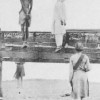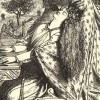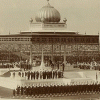
Priti Joshi, “1857; or, Can the Indian ‘Mutiny’ Be Fixed?”
In the 150 years since it occurred, little about the events that shook northern India in the waning days of the East-India Company’s rule has been fixed. The skeletal facts are seldom contested, but their meanings so disputed that what is known appears to recede. Take, for instance, the nomenclature: long known as the “Indian Mutiny,” the events under scrutiny were neither “Indian” (in any pan-Indian or collective sense) nor only a “mutiny.” Alternatives abound—Sepoy Mutiny; Sepoy War; Revolt of 1857; the Uprising of 1857; the Rebellion of 1857; the Great Rebellion; the First War of Independence—each offering an interpretive gloss on the May 1857-June 1858 events. This essay offers an overview of key nodes of debate—who participated and why? who led whom? how planned were the events? how unified were actors—in the current historiography of 1857.

Lorraine Janzen Kooistra, “The Moxon Tennyson as Textual Event: 1857, Wood Engraving, and Visual Culture”
By convention the launch of the so-called “golden age” of wood-engraved illustration in Britain, also known as “the sixties,” is Edward Moxon’s publication, in May 1857, of Alfred Tennyson’s Poems, with 54 wood-engraved illustrations designed by 8 artists, including the Pre-Raphaelites John Everett Millais, William Holman Hunt, and Dante Gabriel Rossetti. Although the Moxon Tennyson was neither a commercial nor critical success on first publication, before the decade was out its Pre-Raphaelite designs were considered a touchstone for artistic illustration, a reputation that continues today. Without disputing the significance of this aesthetic achievement, I want to shift critical focus to the Moxon Tennyson’s status as mass-produced work of art in the age of mechanical reproduction. My interest here is in how its visual communication was expressed through its reproductive technology at the historical moment of its production and reception. This essay re-positions the Moxon Tennyson as a textual event by reading it in the context of documentary, satiric, and artistic wood-engraved images selected from the crucial six-month period after its publication. By situating the Pre-Raphaelite illustrations for Tennyson’s Poems in relation to representations in the public press of such disparate events as the Art Treasures of the United Kingdom Exhibition in Manchester, the reportage on Indian uprisings at Meerut and Cawnpore, the Matrimonial Causes Act, and the Christy Minstrels show in London, I aim to show the complex ways in which the Moxon Tennyson was a worldly event, caught up in, and contributing to, ways of seeing and knowing in 1857.

Julie Codell, “On the Delhi Coronation Durbars, 1877, 1903, 1911”
This essay explores the three Delhi Coronation Durbars and their relationship to topics of spectacle, imperial policy, visual culture, modern media, and Indian and British responses to these events.
